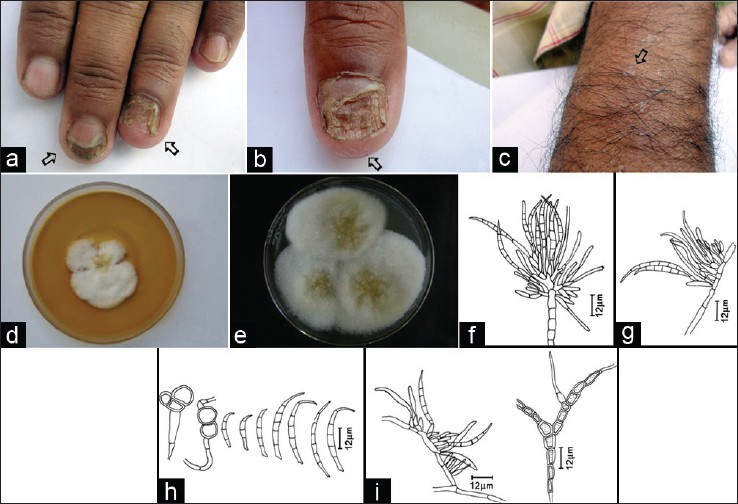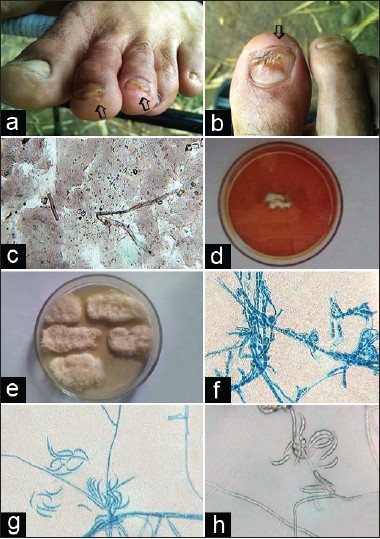Translate this page into:
Fusarial onychomycosis among gardeners: A report of two cases
Correspondence Address:
Geeta Sumbali
Department of Botany, University of Jammu, Jammu - 180 006
India
| How to cite this article: Jandial S, Sumbali G. Fusarial onychomycosis among gardeners: A report of two cases. Indian J Dermatol Venereol Leprol 2012;78:229 |
Sir,
Onychomycosis refers to fungal nail infection that causes the fingernails or toenails to thicken, discolor, disfigure and split. Frequently, it is caused by dermatophytes but now non-dermatophytic moulds are known to account for 2-12% of the nail infections. [1]
In many cases, continuous exposure to physical and chemical aggressions facilitates penetration by different fungal species including the less pathogenic species. One such case is that of gardeners who are commonly exposed to soil saprophytes, which increases their risk of developing onychomycosis. A survey was conducted for onychomycosis among gardeners of Jammu University. Here we report two cases of fusarial onychomycosis caused by Fusarium equiseti and Fusarium heterosporum. These species have not been described previously as agents of onychomycosis.
Nail clippings and scrapings of the suspected gardeners were collected for mycological examination after thorough cleaning with alcohol. These were processed by preparing a wet mount of 20% KOH in DMSO and then counterstained by using Chlorazol Black E. All the samples from suspected cases were cultured irrespective of the negative or positive examination result. Samples were cultured on 2 types of growth medium: DTM (dermatophyte test medium) with cycloheximide and SDA (Sabouraud′s dextrose agar) with chloramphenicol and incubated at 28-30°C for 4-6 weeks. Each sample was subcultured atleast thrice to confirm the results.
Case I of onychomycosis was detected in a 37-year- old gardener who noticed symptoms first on the nail plate of right thumb, followed by nail of the ring and index finger, which then spread to the skin. The nails were thickened, brittle, deformed, opaque and pale to brown, showing nail bed hyperkeratosis but no onycholysis. All these symptoms suggest a case of total dystrophic onychomycosis.
Microscopic examination was negative, but the nail sample cultured on SDA yielded a non-dermatophytic fungus, whose colonies on PSA were initially white, floccose with a tinge of peach. After 7-10 days of incubation, the color changed to beige and finally deep olive buff; reverse was peach coloured. On PSA, SDA and PYE media, the pathogenic isolate did not sporulate. However, on water agar (WA) medium, sparse mycelial growth and abundant sporulation was observed. Macroconidia (3-6 septate) were produced from monophialidic (short, obclavate to doliform) or compact penicillately branched conidiophores. Macroconidia were falcate, with well-developed pedicellate foot cell and an attenuated apical cell. Chlamydospores were present. Based on the above features, the isolate was identified as Fusarium equiseti [Figure - 1].
 |
| Figure 1: Case I showing detection of onychomycosis in a male gardener of Botanical garden: (a, b) Finger and thumb nails showing signs of total dystrophic onychomycosis. (c) Skin showing signs of fungal infection. (d) Colony of Fusarium equiseti arising from affected nail clippings/scrapings. (e) Culture characteristics of Fusarium equiseti on PSA. (f-i) Microscopic details of Fusarium equiseti |
Case II of onychomycosis was detected in a 32-year- old gardener, whose big toenail and little toe fingers of right foot showed disfiguration and discoloration. Affected nails were hard, deformed and pale brown at the edges. Direct mycological test was positive showing hyphal segments.
Nail samples on SDA yielded non-dermatophytic fungal growth. Colonies on PSA were floccose and pale pink. On PSA and PCA, fungus showed very little sporulation; chlamydospores were present. On WA, sparse fungal growth with heavy sporulation was observed. Macroconidia were 1-4 septate, pedicellate with apical cell subulate and narrowing gradually to a point. Based on the above features, the isolate was identified as Fusarium heterosporum [Figure - 2].
 |
| Figure 2: Case II showing detection of onychomycosis in a male gardener of Botanical garden: (a, b) Big toe and little toe finger nails showing signs of onychomycosis. (c) Fungal hyphal segments in a mount of 20% KOH in DMSO. (d) Colonies of fungal pathogen arising from affected nail clippings and scrappings. (e) Culture characteristics of Fusarium heterosporum on PSA. (f-h) Microscopic details of Fusarium heterosporum |
Repeated isolations were performed for both the cases. Same fungal species were consistently isolated with no dermatophytic growth.
Among the causal agents of non-dermatophytic onychomycosis, a number of Fusarium species viz., F. solani, F. oxysporum, F. proliferatum and F. moniliforme have been reported. [2],[3] However, there is no previous report of F. equiseti and F. heterosporum as causal agents.
According to the different workers, these reports are still debatable as none of these fungi are keratlytic. Sometimes they live on unkeratinized intercellular cement or take advantage of partially denatured nail keratin. Therefore, they are generally considered as secondary invaders with pre-existing disease or trauma. [4]
Like other gardeners, predisposing factors in these two cases included poor living conditions, walking barefoot, wearing nylon socks and rubber shoes and doing wet work. All these factors lead to occlusion and perspiration, which results in the maceration of foot tissue and easy germination and penetration of the opportunistic fungal organism. [5] In addition, regular preparation and handling of manure for flower beds may also be responsible for the dissemination of inoculum. Similar results have been reported earlier for gardeners, farmers, forestry workers and housewives working with soil. [4],[5] Garden soils due to their rich humus content and keratinic matter, represents a potential site for myco-keratinophilic species and this increases the risk. In addition, occupation related trauma also paves a way for fungal invasion. This survey suggests that gardeners are also at a risk of onychomycosis. Therefore, to avoid onychomycosis, gardeners need to wear shoes, keep their feet cool and dry, wounds should not be kept open, hands and feet should be properly washed after work and gloves should be worn during work.
| 1. |
Moreno G, Arenas R. Other fungi causing onychomycosis. Clin Dermatol 2010;28:160-3.
[Google Scholar]
|
| 2. |
Gupta AK, Baran R, Summerbell RC. Fusarium infections of the skin. Curr Opin Infect Dis 2000;13:121-8.
[Google Scholar]
|
| 3. |
Hattori N, Shirai A, Sugiura Y, Li W, Yokoyama K, Misawa Y, et al. Onychomycosis caused by Fusarium proliferatum. Br J Dermatol 2005;153:647-9.
[Google Scholar]
|
| 4. |
Gupta M, Sharma NL, Kanga AK, Mahajan VK, Tegta GR. Onychomycosis: Clinico-mycologic study of 130 patients from Himachal Pradesh, India. Indian J Dermatol Venereol Leprol 2007;73:389-92.
[Google Scholar]
|
| 5. |
Sahin I, Kaya D, Parlak AH, Oksuz S, Behset MSO. Dermatophytoses in forestry workers and farmers. Mycoses 2005;48:260-4.
[Google Scholar]
|
Fulltext Views
3,956
PDF downloads
2,664





